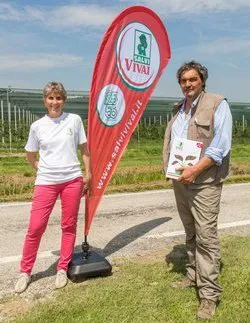 The University of Bologna has been analysing high-density cherry orchards for a few years. Results obtained in the Salvi Vivai test fields confirm what discovered so far and add other interesting elements.
The University of Bologna has been analysing high-density cherry orchards for a few years. Results obtained in the Salvi Vivai test fields confirm what discovered so far and add other interesting elements.FreshPlaza talked about these finds with Stefano Lugli (in the photo with Silvia Salvi), professor at the Deparment of Agricultural Sciences and supervisor of this new public/private research project.
Confirmations from the traditional varieties
Just as shown by previous tests, the Ferrovia, Kordia and Regina cultivars proved suitable for high-density implants. "With 6,000 plants per hectare, we harvested around 500-700 grams per plant on the second year (3-3.5 ton/ha in total) and 1,000-1,200 grams per plant on the third year (6-7 ton/ha) with grades 28 and above in 90% of the cases. The trends we had hypothesised were confirmed and the yield per hectare improved just like the quality of the fruit."
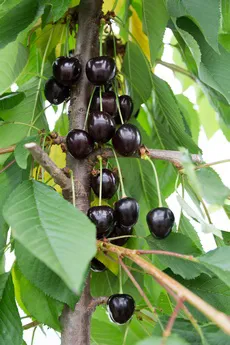 | 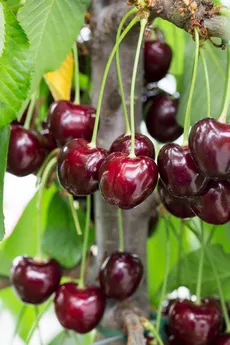 |
New varieties
High-density crops have also proven suitable for other cherry varieties. Grace Star and the Sweet series (patented and licensed by the University of Bologna), for example, are also particularly suitable for these types of implants.
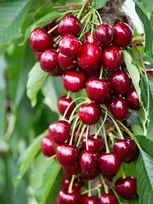 | 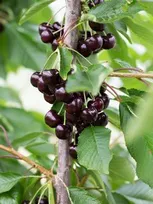 | 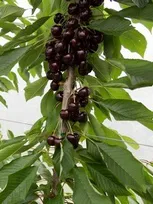 |
Not only were high yields and quality levels guaranteed, but it was also possible to cultivate early or intermediate ripening varieties, thus extending availability by 2-3 weeks. This way, growers have the option to increase their income with the higher prices achieved by the early produce.
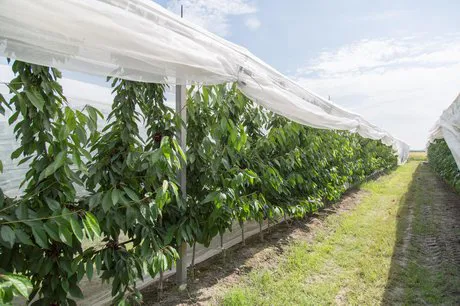
A test field in Runco (FE).
Preform plants are more responsive
"Another important objective achieved by this experimentation concerns the possibility of increasing initial productive performances by improving the quality of the plants produced in nursery gardens. Ideal plants for high-density orchards should have a balanced graft (variety) and root system (rootstock) and be not too high, with short branches and buds."
"The ideal stripling is a traditional vigorous plant produced in nursery gardens with standard cycles, with a two-year-old root system and a one-year-old graft/variety. The new type of plant will have a micro-rootstock of a 3-6-month-old subject (Gisela 5) grown in a vase. At the end of the cycle, we will have a well-balanced stripling of an ideal small size, close internodes perfect for the development of side buds, a higher number of buds at the basis of branches with respect to traditional trees, a higher fruit/flower ratio, better setting and lower pre-harvest drops. All this thanks to an improved physiological balance."
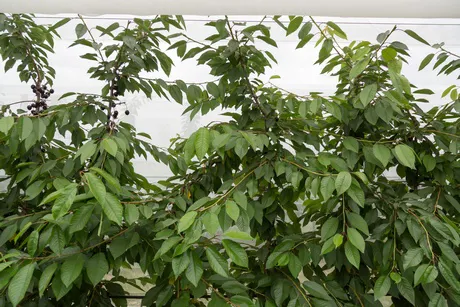
First second-leaf productions obtain with micro-grafts Kordia trees (left) compared to traditional plants (right)
Drosophila and cracking
Multiple defence systems (hail, rain, insects, birds, etc.) adapt very well to high-density orchards thanks to the fact that trees are max. 2-2.5 metres high. A two-year experimentation was carried out also to assess the effectiveness of the Keep in Touch system, a new single-thread covering against the main bioethical and abiotic issues.
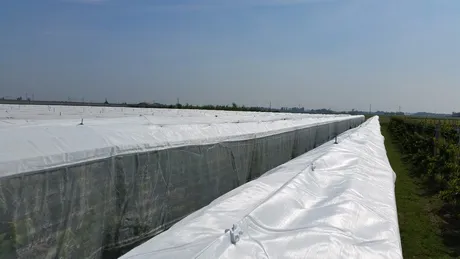
Single-thread covers guarantee an almost-total defence against biotic (insects, brids, etc.) and abiotic (hail, rain, wind) damage.
Optimistic estimates
Thanks to positive results like early fruit production, increases in production, unaltered quality and prices, just to name a few, estimates on how long it would take to recover the investment and profitability are positive.
For further information:
Stefano Lugli
Dipartimento di Scienze Agrarie – Università di Bologna
Email: stefano.lugli@unibo.it
